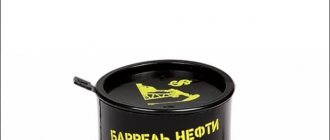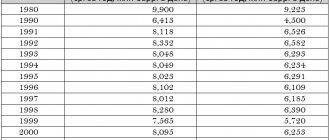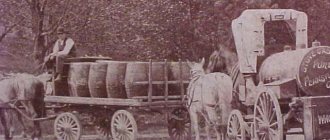- home
- Directory
- units of measurement
- Mass and weight
- What is a barrel? What is 1 barrel equal to in liters?
- What is a barrel
- Metric Barrel Ratio
- One unit with different meanings
- Types of barrels
- Barrel volume
- How many barrels in a ton of oil
- What can you get from a barrel of oil?
One of the main units for measuring the volume of oil production, transportation and purchase/sale in the world is the barrel. A US oil barrel is equal to 42 gallons in English units or 158.988 liters in metric units.
What is a barrel
Formally, the word “ barrel ” is the Russian spelling and sound of the English word barrel , translated as “ barrel ” or “ barrel ”. Barrels of a certain volume served as a quantitative measure in the processes of production, transportation or purchase/sale of oil and petroleum products at the end of the 19th century in the USA, the largest producer and consumer of oil at that time.
In English, an American oil barrel is equal to 42 gallons or 158.988 liters. An agreement on this was reached back in August 1866, which was subsequently consolidated by the United States Petroleum Producers Association in 1972. From a practical point of view, it turned out to be more convenient to estimate the amount of oil by volume rather than by weight.
For the abbreviated name of the barrel, the abbreviation bbl is used, in which the first letter stands for blue. The appearance of this word in the designation of an oil barrel is explained by various legends, from the original color of the barrels used for crude oil to the signature color of the Standard oil of California . In 2013, the world produced about 85 billion barrels of oil, prices for the main brands of which, of course, were set in dollars per barrel.
bar·rel
(băr′əl) n.
1.
A large cylindrical container, usually made of staves bound together with hoops, with a flat top and bottom of equal diameter.
2.
The quantity that a barrel with a given or standard capacity will hold.
3.
Abbr. bar.
or
bbl.
or
bl.
Any of various units of volume or capacity. In the US Customary System it varies, as a liquid measure, from 31 to 42 gallons (117 to 159 liters) as established by law or usage.
4.
A cylindrical or hollow part, especially:
a.
The thicker portion of a baseball bat, from which the most powerful hits are struck.
b.
The cylindrical part of a firearm through which the bullet travels.
c.
A cylinder that contains a movable piston.
d.
The drum of a capstan.
e.
The cylinder within the mechanism of a timepiece that contains the mainspring.
5.
The trunk of a quadruped animal, such as a horse or cow.
6.
The tubular space inside a wave when it is breaking.
7.
Informal
A large quantity:
8.
Slang
An act or instance of moving rapidly, often recklessly, in a motor vehicle.
adj.
Resembling or similar to a barrel, as in shape:
v.
bar·reled
,
bar·rel·ing
,
bar·rels
or
bar·relled
or
bar·rel·ling
v. tr.
To put or pack in a barrel.
v. intr.
Informal
To move or progress rapidly:
Idioms:
on the barrel /barrelhead
Granting, giving, or requesting no credit:
over a barrel
In a very awkward position from which extrication is difficult:
Metric Barrel Ratio
Although the oil barrel is not an official unit of measurement, it is used in many countries around the world and serves as a convenient form of calculating oil production and consumption, for example, the production of 1 barrel per day would be approximately 50 tons of oil per year. In weight terms, 1 barrel, depending on the density and temperature of the oil, is equal to approximately 136.4 kg.
Converting a barrel to metric weights and measures requires knowing the specific gravity of crude oil, which varies significantly from field to field. Typically, API (American Petroleum Institute) degrees are used to measure density. Thus, Russian URALS oil with a density of 31-33 API is heavier than North Sea oil BRENT with a density of 38 API.
One unit with different meanings
In parallel with the oil barrel, in the United States there is also a barrel for measuring other liquid and bulk products, which holds only 31.5 gallons (119.237 l). There is also a so-called dry barrel - 115.6 liters and a beer barrel with a capacity of 31 gallons (117.3 liters).
The English barrel maintains the cultivated identity of the island nation and differs from the American barrel with a capacity of 163.65 liters. France also has its own barrels for wine products called “barriques”, with a volume of 225-228 liters depending on the province.
The barrel is also a national unit of volume in Argentina and Haiti, and a unit of liquid volume in Mexico, Paraguay and Uruguay, again with very different displacement "barrels".
Historically, in the international market, barrels, rather than liters, are used to measure the volume of petroleum products and other liquid, bulk substances. This word is of English origin; translated it means “barrel”.
The barrel has long been used in Western European countries and their former colonies to measure a wide variety of liquid and bulk substances. Beer, ale, oils, gunpowder - all this was measured in barrels. It is noteworthy that in the Russian Empire there was an analogue of a barrel, which was equal to 40 buckets or 491.96 liters.
"Bochka" is a Russian unit of measurement used in the 19th century.
bar•rel
(ˈbær əl) n.,
v. -reled, -rel•ing esp. Brit. -relled, -rel•ling. n. 1.
a cylindrical wooden container with slightly bulging sides made of staves hooped together, and with flat, parallel ends.
2.
a standard quantity that such a vessel can hold, as, in the US, 31.5 gallons of liquid or 105 dry quarts of fruits or vegetables.
3.
any large quantity:
4.
any container, case, or part similar to a wooden barrel.
5.
the tubelike part of a gun from which the projectile emerges.
6.
the cylindrical case in a watch or clock within which the mainspring is coiled.
7.
the trunk of a quadruped, esp.
of a horse or cow. 8.
Also called
throat.
a passageway in a carburetor that has the shape of a Venturi tube.
vt 9.
to put or pack in a barrel or barrels.
10.
to pursue (one's way) or to force (something) to go at high speed.
vi 11.
to travel or drive very fast:
Idioms: over a barrel,
at the mercy of circumstances or one's adversaries;
without choices. [1250–1300; Middle English barril
< Old French
barril
]
Types of barrels
As a rule, many who have heard about barrels and know what it is, associate it only with petroleum products. To be fair, it is worth noting that, indeed, barrel is most often used in this context. Such barrels are called “blue”, and they are equal to 159.988 liters or 136.4 kilograms. They have the international designation BBLS. A barrel of oil is traditionally sold for dollars. The ratio 1 barrel = 42 gallons is also used.
A gallon is a measure of the volume of substances that varies from 3.70 to 4.55 liters depending on what is being measured. For example, in the United States a gallon is 3.785 liters, and in the UK it is 4.546 liters. Like the barrel, the gallon is used in countries where the English metric system was adopted, that is, in the former English colonies. This measurement system is also adopted in Mexico, Argentina, Paraguay, Uruguay and other Latin American countries.
However, there are measures of measurement with a similar name, but a slightly different value. These are English, American and French barrels. It is worth noting that on the domestic Russian market, oil is measured and sold mainly in tons.
The measurement of oil throughout the world is calculated exclusively in barrels.
Barrel volume
As noted above, a barrel is not a single unit of measurement, but an entire system, the values of which vary depending on the substance being measured . For example, the English barrel was formed on the basis of the beer barrel, and since 1824 it has been equal to 163.66 liters. In the United States, the standard barrel for measuring liquid substances originated from the wine barrel and is currently equal to 119.24 liters. It is noteworthy that when measuring beer drinks, the barrel size changes and amounts to 117.3 liters. When determining the volume of dry substances in the United States, a “dry barrel” of 115.6 liters is used.
A French barrel or barrique is equal to 225 liters. It is used as a unit of measurement not in France, but in Haiti. By the way, translated from English, barrel means “barrel”, which, in fact, is clearly understandable when looking at the container.
General information
Barrel is a unit of measurement for oil. This concept was born in England. From English Barrel translates as barrel. And it is not surprising, because at the dawn of the development of the oil industry, due to the lack of special tankers and tanks, transportation of production products from this field of activity was carried out precisely in barrels, which were originally intended for transporting herring. In the global economy, the barrel is used everywhere and is a standard.
Considering these historical facts, a logical question may come to anyone’s mind: “How much is a barrel of oil?” The value of the unit of measurement used to determine the amount of this type of mineral is 42 gallons.
How many barrels in a ton of oil
In Russia and the CIS countries, the concept of “ton” is most often used to measure “black gold” in all purchase and sale processes. In this regard, the question is: “ How much is a barrel of oil in tons ?” — quite often interests people.
To reveal this secret, it is necessary to remember the elementary meanings that are characteristic of any substance and affect its state. Density is a physical quantity equal to the ratio of body mass to volume, measured in g/cm³- and kg/m3. This definition is familiar to everyone from school days, and many laws of physics are associated with this term.
The ability of objects to float on the surface of water, the determination of fluid tension and many other concepts depend and are determined solely by the value of density. Oil, a substance whose normal state corresponds to the term “liquid,” was no exception to the general rule. It is the differences in oil density values, due to historical and geological reasons, that influence some of the digital spread in terms of tons.
Due to the fact that the density of "black gold" is not a single value and varies depending on where it is mined, there are some differences in translation. And since the density of oil directly depends on its temperature, this is also taken into account in the recalculation process.
For example, with an oil density of 750 kg/m3, the number of barrels per ton is:
- at a temperature of 15.60°C - 8.34
With an oil density of 800 kg/m3, the number of barrels per ton will already be equal to:
- at a temperature of 200°C - 8.39
- at a temperature of 200°C - 7.86
- at a temperature of 15.60°C - 7.83
Engine of progress
It is natural resources that are given the leading role in the process of human development. All the activities of the world superpowers are aimed at ensuring their activities and creating a reserve of necessary minerals. The modern world has long forgotten about wars that were started by women, moral values and a sense of duty. For many decades now, people have been dying not for high ideals, but for metal and other material values.
Among the huge number of resources developed by mankind, oil occupies a leading position. “Black gold” is the name that defines the true meaning of this substance in the modern world. The media daily tell the common man about quotes and prices on the world oil market, separately highlighting the importance of such an element as a barrel of oil. A lot depends on the meaning of this mysterious concept: the stability of the world economy, the welfare and budget of individual states and, as a consequence, the fate of millions of ordinary people who do not even suspect what in reality is the key to their measured life. What does this concept mean anyway? What is this mysterious barrel? Let's talk about this in more detail.
What can you get from a barrel of oil?
- gasoline - 102 l
- diz. fuel - 30 l
- aviation fuel - 25 l
- refinery gas - 11 l
- petroleum coke, which is used for the production of electrodes and anti-corrosion equipment - 10 l
- fuel oil - 7 l
- liquefied gas - 5.5 l
- charcoal - 1.5 kg
- propane gas - 12 cylinders
- motor oil - 1 l
- wax candles for cake – 120 pcs
Mass and weightMass Physics Theory Units of measurement
More interesting things in telegram @calcsbox











